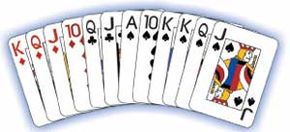Pinochle is a trick-taking game played with a 48-card deck. Here's how to play:
Number of players: Four, playing pairs. All players draw from a deck to determine partnerships. The two players who draw the highest cards form one team. The two players who draw the lowest cards form their opponents. Partners sit opposite each other.
Advertisement
Object: To be the first team to score 1,500 points or more.
The Cards: A 48-card Pinochle deck. The deck can be made up from two standard 52-card decks by removing all 2s through 8s. Remember to use decks that look the same on the back. Cards are ranked from Ace (high)-10-K-Q-J-9 (low).
Dealing: Cut to high card to decide dealer, who deals clockwise. By tradition, deal three cards at a time to each player until each player has 12 cards, the dealer receiving the last batch.
Bidding: Bidding starts at dealer's left. Players may bid or pass on any round. The first bid must be at least 250 points. Bids are raised in ten-point increments. You may pass and then bid later, but three consecutive passes closes the auction. If there is no opening bid during the first round of bidding, the hand is thrown away, and the next dealer shuffles and deals a new hand. Otherwise, the highest bidder becomes the declarer.

Passing: After the declarer names the trump suit, he or she receives four cards from partner. The declarer examines the cards and then passes four cards to partner. The return can include none, some, or all of the cards first passed.
Melding: After this exchange between declarer and partner, all players lay their melds on the table, which are scored for each side.
Scoring the meld: Let's say you win the bid at 360 with a hand of K-Q-J-Q-J-10-A-A-10-K-K-J. You declare spades trump, and your partner passes you the Q, 10, K, Q. You return the A, K, Q, 10 to your partner.
Since you have a good chance of making your contract (even if your partner has no meld points, you only need 150 points in your winning tricks), you decide to play the hand. If, however, your combined meld points are 100 points or less, it would be impossible to make your contract because only 250 points are available in play. In that case, you should not play. As the declarer, you do not need the consensus of your partner to play or not to play. If you don't play, you cannot score your melds and your opponents score the value of their melds plus a 250-point bonus. If, however, you decide to play and your opponents set your contract, you receive no points for your melds and the cards won during play. Your opponents receive the points from their melds, a 250-point bonus, and the points from the cards they took in tricks. When a contract is met, both sides keep all their points.

Playing: The player to the dealer's left leads to the first trick. Play continues clockwise. The winner of each trick leads to the next. You must always follow suit, and if you cannot follow to a nontrump suit, you must play a trump if possible. When a trump is led, you must play a higher trump than the previous trump. You must always play a higher card, if possible. The highest card of the suit led (or the highest trump) wins the trick. When the same card is played twice in a trick (such as the K), the card played first wins the trick.
Advertisement
